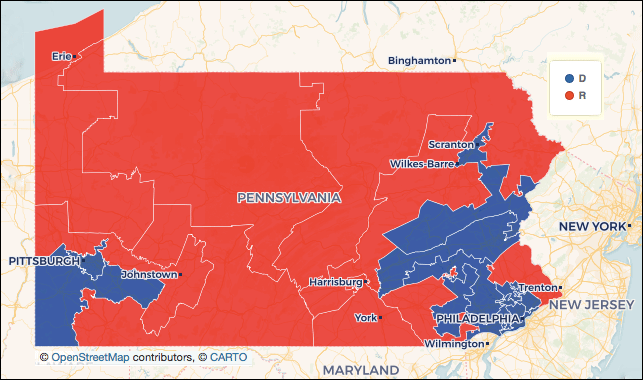By Jim Ellis
Feb. 4, 2019 — As more final voting data becomes available about the 2018 electoral patterns, new local analysis articles are being distributed that allow us to better understand why the results unfolded as they did.
Emily Previti published a piece for Pennsylvania’s Keystone Crossroads media site at the end of last week that details just how the congressional outcome might have changed if the state Supreme Court had not altered the Pennsylvania federal map.
The Pennsylvania high court ruled about a year before the last election that the 2011 redistricting legislative package was a political gerrymander in relation to the state’s constitution. The court then instituted new boundaries for the 2018 and 2020 elections, designed to bridge the gap until the next census, reapportionment, and redistricting processes begin again.
The court majority reasoned that the previous congressional map routinely yielding a 13R-5D congressional result was out of sync with a statewide electorate that usually favors Democrats, among other reasons. Yet, according to the Previti article, such may not have been the case.
After overlaying the new court-imposed 18-district congressional map (above) that returned a 9R-9D result from the previous 12R-6D delegation split (the division changed when Democrat Conor Lamb won an early 2018 special election in a previously Republican 18th CD), Previti concludes that the same 9-9 split we see today may well have occurred even under the previous map.
The Keystone Crossroads staff reconstituted the 2011 map and performed a precinct vote analysis of the 2018 vote. They concluded that Rep. Lamb would have likely won the former District 18 again in the regular election. The other seats that could well have flipped from Republican to Democrat are former districts 6 (Rep. Ryan Costello), 7 (Rep. Pat Meehan), and 15 (Rep. Charlie Dent), assuming that the latter two seats remained open because Dent was leaving office even before the new map was constituted and Meehan resigned because of the taint of a scandal.
In fact, at least in the Dent and Meehan seats, we have actual 2018 examples of congressional races run in those former districts. Because both men resigned before their terms ended, concurrent special elections were called under the previous map to fill the remaining balance of the respective terms. In both cases, the Democratic candidate won.
In the former 7th District, Democrat Mary Gay Scanlon succeeded Rep. Meehan with a 53-46 percent victory over her under-funded Republican opponent.
Turning to the 15th CD, Democrat Susan Wild slipped past her Republican counterpart with a close 48.5 – 48.3 percent win, suggesting that this, too, could have been the outcome had the court not altered the districts.
The article makes that obvious points that candidates, individual situations, campaign and outside resources, and political climate obviously matter, therefore one can’t seamlessly extrapolate votes from one political race to another, even when enough apparent consistency exists to do so.
Gerrymanders are usually defined as creating a series of districts that will elect a certain individual or party member regardless of underlying vote waves. This usually means a party holding a series of seats when the macro trends in that same election are moving in the other political direction.
The Keystone Crossroads research suggests that the previous map may not have been the gerrymander that the court defined, by showing that the 2018 vote results may well yielded the same result that the court-imposed map produced, a latter plan ostensibly free of partisan overtones and bias.
Michael Li is a senior redistricting counsel for the Brennan Center for Justice at New York University Law School, and a key source for Previti’s article. He suggests that the increased midterm turnout was largely responsible for the results in the new districts.
Li described the previous map as a Republican gerrymander that “protected for a 100-year flood,” and that the 2018 election “turned out to be a 500-year flood.” He described the 2018 voter participation factor as a “tsunami.”
Li is making the point that the unusually enhanced turnout favored Democrats to the degree that the previous Republican map would have produced similar results. This is so because turnout increased 43.4 percent when compared to the 2014 midterm. But he fails to include the even larger turnout that occurred in the 2016 presidential year, a turnout that exceed the 2014 level by 74.9 percent. In that year, Republicans held all of their 13 seats at the time, irrespective of the even more pronounced turnout increase.
Therefore, while Li’s analysis may not hold water, the premise that the previous map may not be a gerrymander as the state Supreme Court defined may well be accurate.

